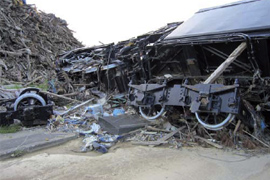The Mitsui & Co. Environment Fund
Introduction to Grant Projects
Tohoku Gakuin University, Faculty of Engineering, Professor Endo Ginro
Development of organism purification technology for soil with inorganic hazardous components caused by the tsunami
Research grant
- Project Description
In order to attain concrete results regarding the clarification of the reality of harmful inorganic compound pollution in Miyagi Prefecture's coastal areas which were damaged by the tsunami, along with cleanup of contaminated soil caused by the tsunami, this project will carry out the following: (1) Selection of plants with high levels of accumulated inorganic hazardous components (2) Analysis of interaction between plants with high accumulation and microorganism transformation to hazardous inorganic compound (3) Development of purification methods of tsunami contaminated soil using plants with high levels of accumulated inorganic hazardous components (4) using plants with high levels of accumulated inorganic hazardous components to analyze cost effectiveness of soil decontamination and propose an agricultural soil remediation policy.
- Fields
- Marine resources/foodPreservation of surface soil and forests
- Grant year
- FY2011 Research Grants
- Grant term
- 3 years and 2 months
August 2011 - September 2014
- Grant amount
- 29,974,068 yen
- Activity region
- Kesennuma, Tagajo, Sendai, Natori, Minamisanriku, Wataricho, Fukushima Prefecture, Japan

Overview of the Organization

- Representative
- Professor Endo Ginro
- Profile
- Specialist field
Environmental biotechnology
Affiliated academic societies
The Society for Biotechnology Japan, Japan Society on Water Environment, Japan Society of Civil Engineers, JSBBA (Japan Society for Bioscience, Biotechnology, and Agrochemistry), Japan Society for Environmental Biotechnology, Japan Society of Microbial Ecology, American Society for Microbiology
Background
In March 1975, graduated from Tohoku University's Faculty of Engineering, and in March 1977, acquired a Master's degree from the same department. In March 1980, graduated from Tohoku University's Graduate School of Civil Engineering as a Doctor. In April of 1980, joined Ebara Jitsugyo Co. Ltd as a researcher, and in April 1987 rejoined Tohoku University as an associate professor. In September 1993, became a visiting researcher at the University of Illinois Chicago School of Medicine, and in April 1995 took the position of a Professor at Tohoku University's Faculty of Engineering. (Current position) - Collaborating researchers
- Tohoku Gakuin University, Graduate School of Environmental Studies, Professor Chihiro Inoue
- Research record
-
- (1) M-F. Chien, M. Narita, K-H. Lin, K. Matsui, C-C. Huang and G. Endo: Organomercurials removal by heterogeneous merB genes harboring bacterial strains. Journal of Bioscience and Bioengineering, Vol.110, No.1, pp.94-98 (2010)
- (2) J-L. Hsieh, C-Y. Chen, M-H. Chiu, M-F. Chien, J-S. Chang, G. Endo and C-C. Huang: Expressing a bacterial mercuric ion binding protein in plant for phytoremediation of heavy metals. J. Hazardous Materials, Vol.161, No.2/3, 920-925 (2009)
- (3) M-F. Chien, S. Tosa, C-C. Huang and G. Endo: Splicing of a bacterial group II intron from Bacillus megaterium is independent of intron-encoded protein, Microbes and Environments, Vol 24, No.1, pp. 28-32 (2009)
- (4) M-F. Chien, C-C. Huang, T. Kusano and G. Endo: Facilities for transcription and mobility of an exonless bacterial group II intron nested in transposon TnMERI1. Gene, No.408, pp.167-171 (2008)
- (5) Itsuaki Masui, et. al: Bacteria and genes that migrate across oceans and continents: Global dispersion of resistance genes and mercury-resistant bacteria, Japanese Journal of Ecology, Vol.57, No.3, PP.390-397 (2007)